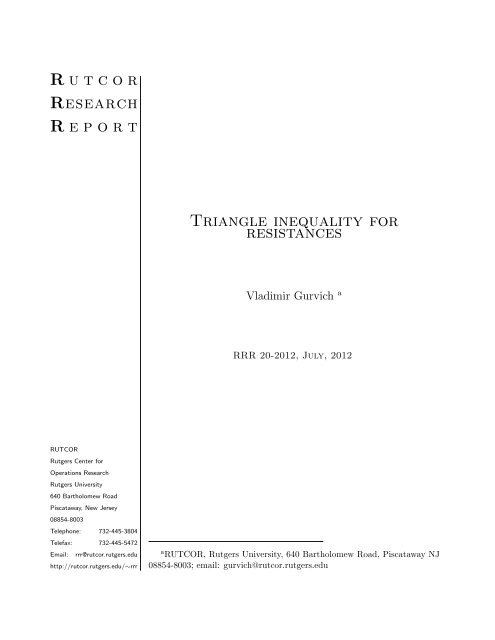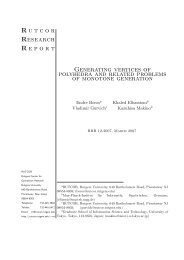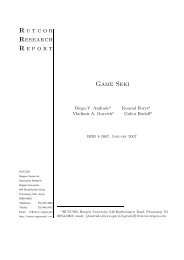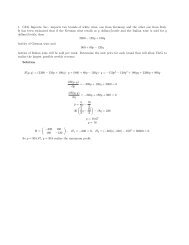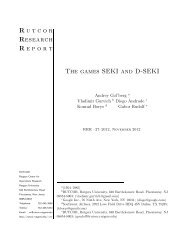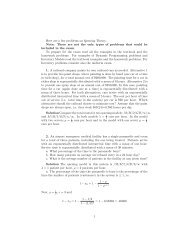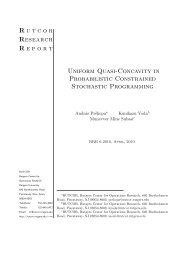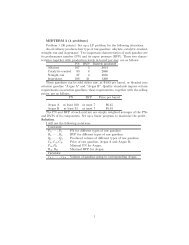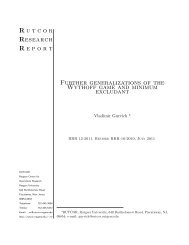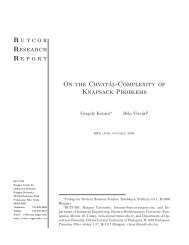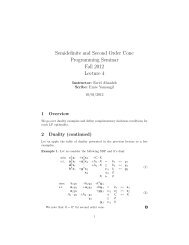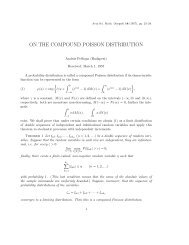Triangle Inequality for Resistances - Rutcor
Triangle Inequality for Resistances - Rutcor
Triangle Inequality for Resistances - Rutcor
You also want an ePaper? Increase the reach of your titles
YUMPU automatically turns print PDFs into web optimized ePapers that Google loves.
R u t c o rResearchR e p o r t<strong>Triangle</strong> inequality <strong>for</strong>resistancesVladimir Gurvich aRRR 20-2012, July, 2012RUTCORRutgers Center <strong>for</strong>Operations ResearchRutgers University640 Bartholomew RoadPiscataway, New Jersey08854-8003Telephone: 732-445-3804Telefax: 732-445-5472Email: rrr@rutcor.rutgers.eduhttp://rutcor.rutgers.edu/∼rrra RUTCOR, Rutgers University, 640 Bartholomew Road, Piscataway NJ08854-8003; email: gurvich@rutcor.rutgers.edu
<strong>Rutcor</strong> Research ReportRRR 20-2012, July, 2012<strong>Triangle</strong> inequality <strong>for</strong> resistancesVladimir GurvichAbstract. Given an electrical circuit each edge e of which is an isotropic conductorwith a monomial conductivity function ye ∗ = ye/µ r s e. In this <strong>for</strong>mula, y e is thepotential difference and ye ∗ current in e, while µ e is the resistance of e, while r ands are two strictly positive real parameters common <strong>for</strong> all edges.In 1987, Gvishiani and Gurvich [4] proved that, <strong>for</strong> every two nodes a, b of thecircuit, the effective resistance µ a,b is well-defined and <strong>for</strong> every three ordered nodesa, b, c the inequality µ s/ra,b≤ µs/r a,c + µ s/rc,bholds. It obviously implies the standardtriangle inequality µ a,b ≤ µ a,c + µ c,b when s ≥ r. In 1992, the same authors showed[5] that the equality holds if and only if c belongs to every path between a and b.Recently, Pavel Chebotarev has found several earlier works of 1967 by Gerald Subak-Sharpe [16, 17, 18] in which the inequality was shown <strong>for</strong> the case s = r = 1.Furthermore, it was rediscovered in 1993 by Douglas J. Klein and Milan Randić.In this report we provide the story of the considered inequality with more details.Key words: distance, metric, ultrametric; potential, voltage, current, Ohm law,Joule-Lenz heat, Maxwell’s minimum energy dissipation principle, pressure, flow,maximum flow, minimum cut, shortest path, bottleneck path.
Page 2 RRR 20-2012In the Moscow Institute of Physics and Technology they teach five semesters of generalphysics. The third one is Electricity. So, in December of 1970, I had to take the exam.Traditionally, it begins with a topic chosen by the student. I chose to compute the resistanceof a n-node network that contains ( n2)passive resistances, only. From high-school, I was surethat there should be a <strong>for</strong>mula. In 1970, I was able derive it, having the concept of adeterminant in my possession.It was not too difficult. Take the n × n matrix L whose entry λ i,j is the conductanceof the edge e i,j between nodes i and j (if there is none, λ i,j = 0) and λ i,i is the sum of allconductances in the row (or column) i. The rest is simple. Eliminate row i and column j(respectively, two rows and two columns i and j) from L and denote the obtained matrix byL ′ i,j (respectively, by L ′′i,j). Then the effective conductance Λ i,j between the poles i and j isjust the ratio of the corresponding two determinants, more precisely,Λ i,j = | det L ′ i,j/ det L ′′i,j|. (1)I still do not know who was the first to derive this <strong>for</strong>mula; perhaps, Kirchhoff knew it,already. (Actually, L is called the so-called Laplace matrix.) Yet, I felt that did more thanthey do during the 8th year of the high-school computing “infinitely” many resistances ofseries-parallel networks. But will it be enough to impress the examiner? I was not completelysure of it and decided to check the triangle inequality <strong>for</strong> the corresponding resistances:Λ −1i,k + Λ−1 k,j ≥ Λ−1 i,j ∀ i, j, k. (2)To my pleasant surprise, (2) indeed followed from (1), but not that easily. It took severalhours and pages to derive it.Next morning I reported, with pride, all this to an examiner. But, to my unpleasantsurprise, he was not happy. Not at all.- What devices are in your networks?- Only passive resistances.- And this is all?! No capacitors, launching coils, or generators?!- No, nothing like that...- How dare you to come with this?! We taught you Maxwell equations... And here...<strong>Resistances</strong>!I shrugged this question off. He was pretty loud, so another examiner came to us andsaved me from almost certain failure. I vaguely recall that his name was Kaloshnikov andhe was teaching PhysLabs.- What is all this noise about?My examiner explained.- So what?! I find all this curious. Let me finish the exam with this student...In fact, they demonstrated two possible reactions to resistance distances that are stilltypical <strong>for</strong> chemists, physicists, and electrical engineers.
RRR 20-2012 Page 3I should confess that I did not give much importance to this result either and did notpublish it until 1987. Thenadays, I was working <strong>for</strong> the Schmidt Institute of Physics ofthe Earth of the Soviet Academy of Sciences, in the Laboratory of Mathematical Methodsof Earthquakes Prediction directed by Alexei Gvishiani. He was graduated in 1975 fromMech.-Mat. MSU, where studied functional analysis advised by Israel Gelfand and AlexanderKirillov. (Also, he is a grandson of the Soviet prime minister, Alexei Kosygin, 1904–1980.)Although network resistances are pretty far from earthquakes, yet, not farer than thefunctional analysis is. So Gvishiani and I decided to generalize and publish the result.We replaced the classical Ohm law ye ∗ = y e /µ e by a monomial conductivity lawy ∗ e = y r e/µ s e, (3)where e is a conductor of the network, y e is the tension (or the potential drop) on e and y ∗ eis the current through e, furthermore, µ e is the resistance of e, while r and s are real strictlypositive parameters that do not depend on e.For example, the quadratic law, r = 1/2, is typical <strong>for</strong> hydraulics or gas dynamics, wherey e is the pressure drop and y ∗ e is the flow through the pipe e.It appears that the effective resistance µ i,j is well defined <strong>for</strong> any two nodes i, j, and <strong>for</strong>every three ordered nodes i, j, k the following metric inequality holds:µ s/ri,k + µs/r k,j ≥ µs/r i,j ∀ i, j, k. (4)Interestingly, there are several proofs <strong>for</strong> the linear conductivity law, r = 1. Yet, I knowonly one general proof, but it is certainly the simplest one.Let us fix potentials x i and x j in the nodes i and j. Without any loss of generality,assume that x i ≥ x j . Then, some current yi,j ∗ will flow from i to j and some potential x k inthe node k will appear such that x i ≥ x k ≥ x j .Now, let us similarly fix x i and x k and determine the flow yi,k ∗ . All we have to prove isthe inequality yi,j ∗ ≥ yi,k ∗ . And this is not difficult. Then, by symmetry, we have y∗ i,j ≥ yj,k ∗ .Finally, any good high-school student could derive the triangle inequality from the the abovetwo inequalities as follows.y ∗ i,j = (x i − x j ) rµ s i,j≥ (x i − x k ) rµ s i,k= y ∗ i,k; y ∗ i,j = (x i − x j ) rµ s i,j≥ (x k − x j ) rµ s k,j= y ∗ k,j, (5)which can be obviously rewritten as(µi,kµ i,j) s/r≥ x i − x kx i − x j;(µk,jµ i,j) s/r≥ x k − x jx i − x j. (6)Summing up these two inequalities one gets exactly (4).
Page 4 RRR 20-2012It is also easy to show that (4) holds with equality iff yi,j ∗ = yi,k ∗ = y∗ k,j , which happensiff node k belongs to every path between the nodes i and j. The metric spaces that havethe latter properties are called geodetic [2]. However, we noticed the geodetic property ofresistance distances only later, when the paper was already published. So, this observationappeared only in 1992, in our book [5] published in Russian. For the linear case, r = s = 1it was rediscovered “in the next millenium”; see <strong>for</strong> example, [2].To submit our result, we chose the journal of “Functional Analysis and its Applications”,founded and led by Israel Gelfand. I still believe that the metric inequality <strong>for</strong> resistancesdoes belong to the functional analysis. Moreover, as far as applications are concerned, ourpaper was just fine, unlike most of the papers in this journal.However, Gelfand was not too happy. I can only guess about his reasons. Perhaps,in contrast to my physics-examiner, who decided that there are no serious “devices” and(2) is too ”mathematical”, Gelfand decided that there are too many “devices” and (4) isnot enough “functionally analytic”. Anyway, he suggested to withdraw the paper from”Functional Analysis” and resubmit it to the “Communications of the Moscow Math. Soc.in Russian Math. Surveys.” This was a good journal and a reasonable compromise.It would be natural <strong>for</strong> Gelfand to call Gvishiani, his <strong>for</strong>mer student, and tell him theverdict. Yet, he chose a more sophisticated way. I got a call from Andrei Zelevinsky,my <strong>for</strong>mer classmate and another Gelfand’s student (perhaps, the best one; now he is afamous mathematician, the inventor of Cluster Algebras). I asked Andrei what is wrongwith submitting to the “Functional Analysis” and got a pretty curious answer. He said thatit is one of a few journals that have a peculiar style and submitting our paper there is likecoming in a ski suit (although in a very good one) to a banquet, where all other wear fracs.Anyway, the offer was decent and it was accepted. The only disadvantage (but quite aserious one) was that I had to squeeze the eight pages long paper to just two pages, becausethe “Comm. of the Moscow Math. Soc.” were (and still are) strictly limited to this size.In any case, the paper [4] was never cited be<strong>for</strong>e I republished a more detailed (10 pages)version of it in the “Discrete Applied Mathematics”, in 2010 [7]. Also, I presented the metricinequality <strong>for</strong> resistances and some related results as a series of the “high-school problems”in the Russian journal Mathematical Enlightenment [6].It was recently (in the Fall of 2011) discovered by Pavel Chebotarev that the metricinequality, <strong>for</strong> the linear case, r = s = 1, was published much earlier, in 1967, by Gerald E.Subak-Sharpe [16, 17, 18], a Professor of Electrical Engineering from New York City. Till2012 his works were not cited either. Professor Subak-Sharpe passed away [19] on September11th, 2011, just shortly be<strong>for</strong>e his breakthrough of 1967 was finally recognized by colleagues.The name ”resistance distance” was coined later by Douglas J. Klein and Milan Randić.They also rediscovered the metric inequality, <strong>for</strong> the linear case, and published it in 1993 inthe J. of Math. Chemistry [9]. Their paper got 111 citations.
RRR 20-2012 Page 5References[1] D. Babić, D.J. Klein, I. Lukovits, S. Nikolić, and N. Trinajstić, Resistance-DistanceMatrix: A Computational Algorithm and Its Applications, Int. J. Quant. Chem. 90(2002) 166-176.[2] P. Chebotarev, A class of graph-geodetic distances generalizing the shortest-path andthe resistance distances, Discrete Applied Mathematics 159:5 (2011) 295-302.[3] M. Deza and E. Deza, Encyclopedia of Distances, Springer-Verlag, 2009.[4] A.D. Gvishiani and V.A. Gurvich, Metric and ultrametric spaces of resistances,Communications of the Moscow Mathematical Society, in Russ. Math. Surveys, 42:6(258) (1987) 235–236.[5] A.D. Gvishiani and V.A. Gurvich, Dynamical classification problems and convexprogramming in applications, Moscow, Nauka (Science), 1992 (in Russian).[6] V.A. Gurvich, Metric and ultrametric spaces of resistances, Math. Enlightenment 13(2009) 134–141 (in Russian).[7] V.A. Gurvich, Metric and ultrametric spaces of resistances, Discrete Applied Math. 158(2010) 1496–1505.[8] D.J. Klein, J.L.L. Palacios, M. Randić, and N. Trinajstić, Random Walks and ChemicalGraph Theory, J. Chem. Inf. Comput. Sci. 44:5 (2004) 15211525.[9] D.J. Klein and M.J. Randić, Resistance distance, J. Math. Chem., 12 (1993) 81-95.[10] D.J. Klein, Resistance-Distance Sum Rules, Croat. Chem. Acta 75 (2002) 633-649.[11] O.V. Lyashko, Why resistance does not decrease? Kvant 1 (1985) 10-15 (in Russian).English translation in Quant. Selecta, Algebra and Analysis II, S. Tabachnikov ed.,AMS, Math. World 15 (1999) 63-72.[12] L. Lukovits, S. Nikolić, and N. Trinajstić, Resistance Distance in Regular Graphs, Int.J. Quant. Chem. 71 (1999) 217-225.[13] L. Lukovits, S. Nikolić, and N. Trinajstić, Note on the Resistance Distances in theDodecahedron, Croat. Chem. Acta 73 (2000) 957-967.[14] Minty G. J. Monotone networks // Proceedings of the Royal Society of London, Ser. A257 (1960) 194–212.[15] J.L.L. Palacios, Closed-Form Formulas <strong>for</strong> Kirchhoff Index, Int. J. Quant. Chem. 81(2001) 135-140.
Page 6 RRR 20-2012[16] G.E. Sharpe, Solution of the (m+1)-terminal resistive network problem by means ofmetric geometry, in: Proceedings of the First Asilomar Conference on Circuits andSystems, Pacific Grove, CA (November 1967) 319–328.[17] G.E. Sharpe, Theorem on resistive networks, Electron. Lett. 3 (1967) 444–445.[18] G.E. Sharpe, Violation of the 2-triple property by resistive networks, Electron. Lett. 3(1967) 543544.[19] Gerald Subak-Sharpe died on Sep. 26th 2011, Obituary athttp://www.columbiapaper.com/index.php/obituaries/2243-by-staff .[20] W. Xiao and I. Gutman, Resistance Distance and Laplacian Spectrum, Theor. Chem.Acc. 110 (2003) 284-289.[21] Wikipedia, Resistance Distance, athttp://en.wikipedia.org/wiki/Resistance distance .[22] WolframMathWorld, Resistance Distance, athttp://mathworld.wolfram.com/ResistanceDistance .


